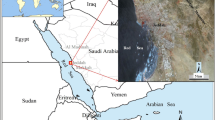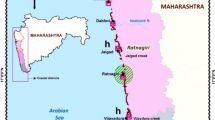Abstract
Coastline changes are caused by sea-level rise, erosion and anthropogenic activities, and have important consequences on coastal ecosystems and communities. In this study, shore line changes during the last 40 years near the Mahi estuarine belt in the Gulf of Khambhat region have been monitored using multi-temporal Landsat data from 1978 to 2018. Multi-date Landsat digital data with 10-year interval from 1978 to 2018 was downloaded from the website https://earthexplorer.usgs.gov/. The Landsat data covering the study area with 15-km buffer was extracted and analyzed for monitoring the changes in the shoreline. The Normalized Difference Water Index (NDWI) images were also generated for delineation of the shoreline. The data was analyzed using the Digital Shoreline Analysis System in ArcGIS software, which provides a set of tools permitting transects-based calculation of shoreline displacement. A total number of 10 transects from the centre of the village up to the coast line were marked on the multi-date Landsat digital data. The changes in the shoreline from the centre of the village were calculated using the End Point Rate (EPR) and temporal linear regression model to predict future shoreline position. The decadal shoreline change indicated that shoreline has continuously increased from 113.9 to 831.4 m during the 40-year period from 1978 to 2018, respectively. This indicates that total migration of shoreline towards the land area of the study village during the last 40 years (1978 to 2018) was 1590.5 m with an alarming annual rate of change of 39.76 m year−1, which is very remarkably high and alarming which may lead to any future disaster for the study village. The coastline was not significantly changing until 1988; however, change in coastline is exponentially faster from 1989 to 2018. The linear regression method was adopted for predicting the shoreline change rates over the entire period of the study from 1978 to 2018 and from 2018 to 2028 and 2038. The results of shoreline change prediction for future 10 years (2028) and 20 years (2038) indicate the average predicted transect length of 1908 m and 1543 m, respectively. With the projected estimates of shoreline change during next 20 years at the rate of almost 120 m/year, it appears that the Chokari village may get submerged in the sea water. The analysis of change in the land surface area of the Chokari village indicated that it has decreased from 12.45 to 9.63 km2, which indicates that area reduced by 2.8 km2 may be due to the erosion along the river-bed which is the result of change in the shoreline during the last 40 years. Based on these results of shoreline change analysis, it is recommended that the Government of Gujarat needs to take immediate steps to protect the Chokari village from submergence by adopting Integrated Coastal Zone management strategies.












Similar content being viewed by others
References
Ajai BM, Unnikrishnan AS, Rajawat AS, Bhattacharya S, Ramakrishnan R, Kurian NP, Hameed S, Sundar D (2013) Demarcation of coastal vulnerability line along the Indian coast. J Geom 7(1)
Al-Hatrushi S (2013) Monitoring of the shoreline change using remote sensing and GIS: a case study ofAlHawasnah tidal Inlet, AlBatinah coast, Sultante of Oman. Arab J Geosci 6(5):1479–1484
Barnard P, Short A, Harley M et al (2015) Coastal vulnerability across the Pacific dominated by El Niño/Southern Oscillation. Nat Geosci 8:801–807. https://doi.org/10.1038/ngeo2539
Bhatti, Hiren, Ramakrishnan, Ratheesh, Sharma, A. K. and Rajawat, A. S., 2018. Extensive erosion of mudflats changes shoreline in Gulf of Khambhat. India Science Wire,
Boak EH, Turner IL (2005) Shoreline definition and detection: a review. J Coast Res 214:688–703
Cazenave A, Cozannet GL (2014) Sea level rise and its coastal impacts. Earth’s Future 2:15–34
Chander G, Markham BL, Helder DL (2009) Summary of current radiometric calibration coefficients for Landsat MSS, TM, ETM+, and EO-1 ALI sensors. Remote Sens Environ 113:893–903
Chen S, Chen L, Liu Q, Li X, Tan Q (2005) Remote sensing and GIS based integrated analysis of coastal changes and their environmental impacts in Lingding Bay. Pearl River Estuary, South China
Church JA, Gregory JM (2001) Changes in sea level. In: Houghton JT, Ding Y, Griggs DJ, Noguer M, van der Linden PJ, Dai X, Maskell K, Johnson CA (eds) Climate change 2001. The scientific basis: Contribution of Working Group I to the third assessment report of the intergovernmental panel on climate change. Cambridge University Press, Cambridge, pp 639–694
Church JA et al (2004) Changes in sea level. In: Houghton JT et al (eds) Climate Change 2001: the scientific basis. Cambridge Univ. Press, New York, pp 639–694
Church JA, White NJ, Hunter JR (2006) Sealevel rise at tropical Pacific and Indian Ocean islands. Glob Planet Chang 53:155–168
Crowell M, Leatherman SP, Buckley MK (1991) Historical shoreline change—error analysis and mapping accuracy. J Coast Res 7:839–852
Crowell M, Douglas BC, Leatherman SP (1997) On forecasting future U.S. shoreline positions—a test of algorithms. J Coast Res 13:1245–1255
Cui BL, Li XY (2011) Coastline change of the Yellow River estuary and its response to the sediment and runoff (1976-2005). Geomorphology 127:32–40
Das and Radhakrishna (1993) Trends and pole tide in Indian tide gauge records. In: Proceedings of the Indian Academy of Sciences. Earth and Planetary Sciences
Dolan R, Fenster MS, Holme SJ (1991) Temporal analysis of shoreline recession and accretion. J Coast Res 7(3):723–744
Douglas B (2001) Sea-level change in the era of the recording tide gauge, in Sea Level Rise: History and Consequences, Int. Geophys. Ser., vol. 75, edited by B. Douglas, M. Kearney, and S. Leatherman, chap. 3. Academic, San Diego, Calif, pp. 37– 64
Durduran SS (2010) Coastline change assessment on water reservoirs located in the Konya Basin Area, Turkey, using multi-temporal Landsat imagery. Environ Monit Assess 164:453–461
Duru U (2017) Shoreline change assessment using multi-temporal satellite images: a case study of Lake Sapanca, NW Turkey. Environ Monit Assess 189:385. https://doi.org/10.1007/s10661-017-6112-2
Elnabwy MT, Elbeltagi E, El Banna MM, Elshikh MMY, Motawa I, Kaloop MR (2020a) An approach based on Landsat images for shoreline monitoring to support integrated coastal management—a case study, Ezbet Elborg, Nile Delta, Egypt. ISPRS Int J Geo-Inf 9:199. https://doi.org/10.3390/ijgi9040199
Gens R (2010) Remote sensing of coastlines: Detection, extraction and monitoring. Int J Remote Sens 31:1819–1836
Holgate SJ, Woodworth PL (2004) Evidence for enhanced coastal sea level rise during the 1990s. Geophysical Research Letters 31(7)
Joshi JP, Dabral S, Bhatt B (2013) Quantitative assessment of coastal changes between Narmada and Kim River of South Gujarat, India. Int J Geol Earth Environ Sci ISSN: 2277-2081 3(3):89–95
Kannan R, Kanungo A, Murthy MVR (2016) Detection of shoreline changes Visakhapatnam Coast, Andhra Pradesh from multi-temporal satellite images. J Remote Sens GIS 5:157. https://doi.org/10.4172/2469-4134.1000157
Kuleli T (2010) Quantitative analysis of shoreline changes at the Mediterranean Coast in Turkey. Environ Monit Assess 167:387–397
Le Cozannet G, Garcin M, Yates M, Idier D, Meyssignac B (2014) Approaches to evaluate the recent impacts of sea-level rise on shoreline changes. Earth-Sci Rev 138:47–60
Leatherman SP, Douglas BC, Crowell M (1997) Beach erosion trends and shoreline forecasting. J Coast Res 13(4)
Li R, Liu JK, Felus Y (2001) Spatial modelling and analysis for shoreline change detection and coastal erosion monitoring. Mar Geod 24:1–12
Louati M, Saïdi H, Zargouni F (2014) Shoreline change assessment using remote sensing and GIS techniques: a case study of the Medjerda delta coast, Tunisia. Arab J Geosci. https://doi.org/10.1007/s12517-014-1472-1
Mahapatra M, Ratheesh R, Rajawat AS (2013) Shoreline change monitoring along the south Gujarat coast using Remote sensing and GIS Techniques. Int J Geol Earth Environ Sci ISSN: 2277-2081
McFeeters SK (1996) The use of the Normalized Difference Water Index (NDWI) in the delineation of open water features. Int J Remote Sens 17(7):1425–1432
Nandi S, Ghosh M, Kundu A, Dutta D, Baksi M (2016) Shoreline shifting and its prediction using remote sensing and GIS techniques: a case study of Sagar Island, West Bengal (India). J Coast Conserv 20:61–80
Nicholls RJ, Leatherman SP (1995) The implications of accelerated sea-level rise and developing countries: a discussion. [in special issue: 14: Potential Impacts of Accelerated Sea-Level Rise on Developing Countries] Journal of Coastal Research, Spring Issue, 303–323
Pham BT, Prakash I (2018) Application of simple remote sensing techniques for detection and extraction of coastline-a case study of Diu Island, India. Indian J Ecol 45(4):778–784
Rosenzweig C, Casassa G, Karoly DJ, Imeson A, Liu C, Menzel A, Rawlins S, Root TL, Seguin B, Tryjanowski P (2007) Assessment of observed changes and responses in natural and managed systems. Climate Change 2007: Impacts, Adaptation and Vulnerability. In: Parry ML, Canziani OF, Palutikof JP, van der Linden PJ, Hanson CE (eds) Contribution of Working Group II to the Fourth Assessment Report of the Intergovernmental Panel on Climate Change. Cambridge University Press, Cambridge, pp 79–131
Scott DB (2005) Coastal changes, rapid. In: Encyclopaedia of coastal science, pp 253–255
Shaw JB, Wolinsky MA, Paola C, Voller VR (2008) An image-based method for shoreline mapping on complex coasts. Geophys Res Lett 35:L12405
Sherman DJ, Bauer BO (1993) Coastal geomorphology through the looking glass. Geomorphology 7:225–249
Smith MJ, Cromley RG (2012) Measuring historical coastal change using GIS and the change polygon approach. Trans GIS 16(1):3–15
Srinivasu U, Ravichandran M, Han W, Sivareddy S, Rahman H, Li Y, Nayak S (2017) Causes for the reversal of North Indian decadal sea level trend in recent two decades. Clim Dyn:1–18
Stutz ML, Pilkey OH (2011) Open-ocean barrier islands: global influence of climatic, oceanographic, and depositional settings. J Coast Res 272
Thieler ER, Himmelstoss EA, Zichichi JL, Ayhan E (2009) Digital Shoreline Analysis System (DSAS) version 4.0. An ArcGIS extension for calculating shoreline change: U.S. Geological Survey Open-File Report 2008–1278
Thom BG, Cowell PJ (2005) Coastal changes, gradual. In: Schwartz ML (ed) Encyclopaedia of coastal sciences. Springer, Dordrecht, pp 251–253
Unnikrishnan AS, Shankar D (2007) Are sea-level-rise trends along the coasts of the north Indian Ocean consistent with global estimates? Glob Planet Chang 57(3-4):301–307
Vousdoukas MI, Mentaschi L, Voukouvalas E, Verlaan M, Jevrejeva S, Jackson LP, Feyen L (2018) Global probabilistic projections of extreme sea levels show intensification of coastal flood hazard. Nat Commun 9:2360 (2018). https://doi.org/10.1038/s41467-018-04692-w
Xu N (2018) Detecting coastline change with all available Landsat data over 1986–2015: a case study for the State of Texas, USA. Atmosphere 2018(9):107
Xu N, Gong P (2018) 2018. Significant coastline changes in China during 1991-2015 tracked by Landsat data. Sci Bull 63:883–886. https://doi.org/10.1016/j.scib.2018.05.032
Zuzek PJ, Nairn RB, Thieme SJ (2006) Spatial and temporal consideration for calculating shoreline change rates in the Great Lakes Basin. J Coast Res 38:125–146
Author information
Authors and Affiliations
Corresponding author
Ethics declarations
Conflict of interest
The authors declare that they have no conflict of interest.
Rights and permissions
About this article
Cite this article
Patel, K., Jain, R., Patel, A.N. et al. Shoreline change monitoring for coastal zone management using multi-temporal Landsat data in Mahi River estuary, Gujarat State. Appl Geomat 13, 333–347 (2021). https://doi.org/10.1007/s12518-021-00353-8
Received:
Accepted:
Published:
Issue Date:
DOI: https://doi.org/10.1007/s12518-021-00353-8




